Ent 104 Midterm 2
1/90
There's no tags or description
Looks like no tags are added yet.
Name | Mastery | Learn | Test | Matching | Spaced |
|---|
No study sessions yet.
91 Terms
dendrite
receives information from sensory structure, tissue, or another neuron
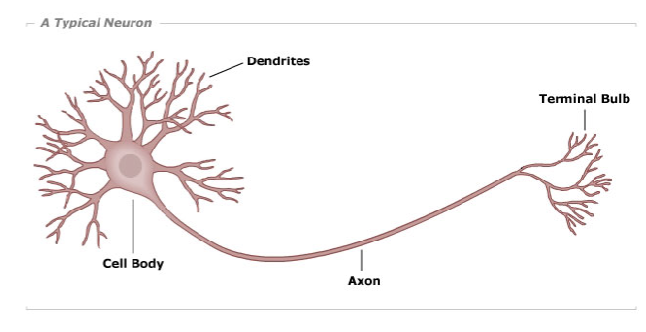
Axons
Send info away from neuron
can send info to:
another neuron
glandular structure
effector
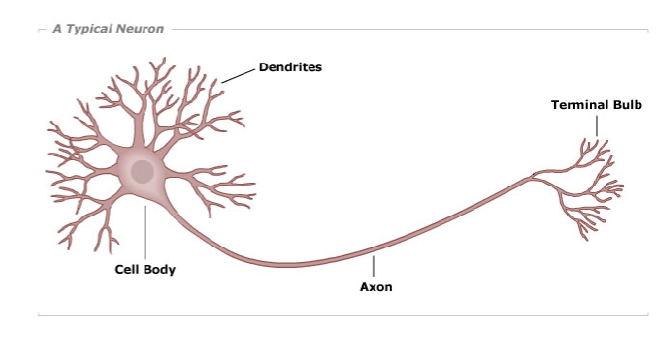
Synapses
where axons and dendrites meet
neurotransmitters trigger the next neuron to fire
neuromodulators change the likelihood of the neuron firing
can be simple (one to one) or complex (one to many)
Effector
receives input and does something
muscle or gland changes function in response to a signal from a brain center
types of insect gaits
Simple (classic tripod gait)
Complex
roaches can sprint on hind legs alone and gallop like a horse
when legs are surgically removed new stereotyped pattern can be immediately used
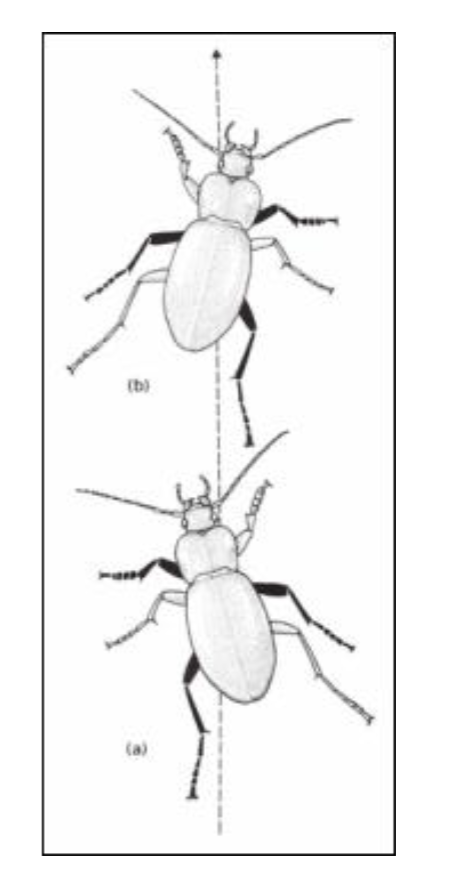
Stereotyped behaviors
flight
digging
eating
reproduction
predation
anti-predation
signaling
in some sense nearly all insect behaviors are sterotyped as cyclical or one time cue responses
Central pattern generators
nerves organized into fixed circuits that control stereotyped periodic behavior like walking
can function independent of sensory inputs
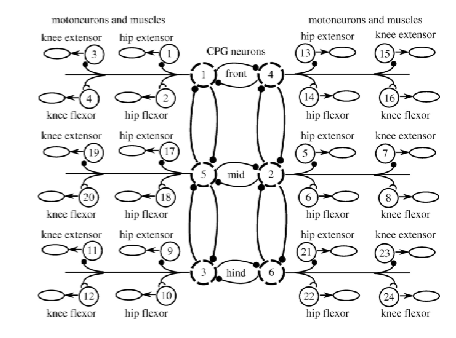
Physical models
physical models can be useful compared to mathematical or computer models because they show actual responses and physical representations
reflexes
fixed neuronal circuit that links external info to an immediate fixed response
distributed nervous system
insects have distributed nervous system
knee jerk response
ganglia function as mini brains and can handle more tasks than in vertebrates with bigger brains
evolution of decisions
decisions evolved from reflexes
1- information received by sensory structures
2- information is filtered, only useful info is kept
3- signal is sent to the brain, again filtered and integrated
4- signal sent out to effectors to change behavior
neuroethology (colony mate recognition)
hypothesis 1: individual compares smell of another to template in the brain (central nervous system)
hypothesis 2: individual is habituated to odor of nestmates and is alerted when they smell something different (peripheral nervous system)
4 classes of sensory information
mechanical stimuli
thermal stimuli
chemical stimuli
visual stimuli
trichoid sensilla
basic insect tactile structure
hair connected to a neuron
movement of the hair squeezes the dendrite of the sensory neuron causing it to fire
trichoid sensilla are very sensitive and can sense air currents and touch easily
proprioceptors
structures that measure the position of one body segment relative to another
important for balance
come in two forms: hairs and cuticle structures
types of proprioceptors
hair (most basic)
campaniform (senses stress on cuticle)
chordotonal (highly derived; sense substrate vibrations)
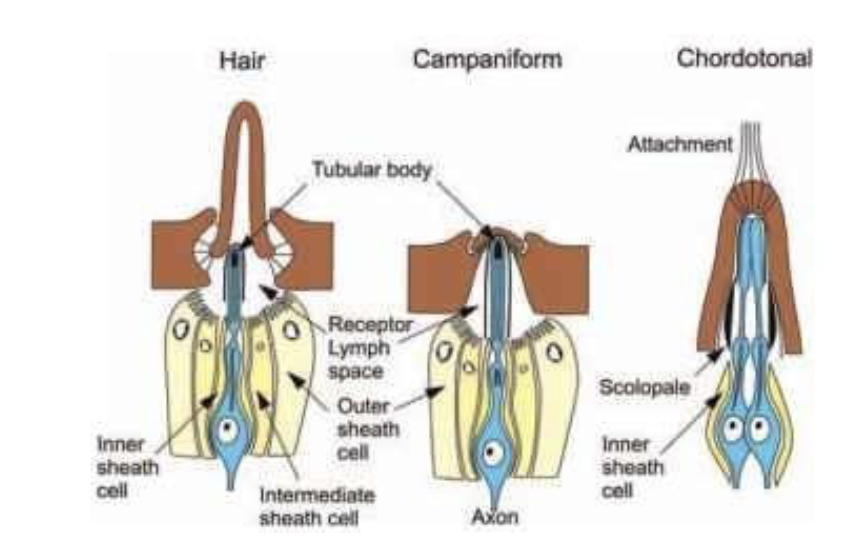
sound receptors
sound receptors are modified proprioceptors
substrate vibrations are sensed with the subgenual organ
Johnstons organ
simple hearing
located on antenna
sense air speed via antenna deflection
tympanic organ
elaborate ears
thin membrane connected to an air sac that vibrates when sound hits it (eardrum)
can be anywhere on the insect
most insects dont have this, only ones that need it (eg moths and insects that sing to find mates)
Jamming (moths and bats)
bats use echolocation to locate prey in the dark; moths have evolved ears to know when they are being hunted
some moths can send back ‘jamming’ noises to make echolocation less effective
moths often also use other strategies like irregular flight pattern or dropping to the ground
thermosensors and thermoregulation in insects
poorly understood in insects
receptor is in antenna in most insects
insects lose heat fast because of small body size
can heat themselves up with flight muscles immediately before taking off
honey bee thermoregulation
create a warm cluster to keep warm through winter
bees in the center of the cluster generate heat
bees at the edge of the cluster provide insulation
bees rotate between edge and center
allows bees to start foraging earlier in the spring
How do asian honey bees use thermoregulation to kill hornets
asian honey bees form a cluster around a hornet that has invaded the nest and heat themselves up in order to kill the hornet
this works because the bees have a higher heat tolerance than the hornet
only asian honey bees can do this
chemoreception
includes both taste and smell
1- molecules are trapped in viscous substance
2- odorant binding proteins carry molecules to odorant receptor proteins on sensory neurons which trigger neuron firing
types of sensory structures
antennae (smell and taste)
mouthparts (taste)
feet, ovipositor, etc (taste)
*chemosensory structures can be in many places on the body depending on what the species needs
Types of eyes
Larva:
stemmata— good at detecting light, poor at resolving
mainly used for detecting light and dark
Adults:
Ocelli— 3 on top of the head; very sensitive to light
ocelli may be horizon detectors used in flight
Compound eyes— main source of vision
Insect Vision
Poor resolution (vision is pixelated)
Good ability to sense movement (higher fusion flicker rate)
Insects can see UV and polarized light
Most cannot see in the dark
cues
information left passively in the environment by an animal
can be used by anyone
eg tracks, odors, sounds
Signals
Information intentionally sent by one animal to another (usually within species)
can be used by others (eavesdropping)
How do signals evolve from cues
signals= exaggerated cues
For example, threat signals evolve from the moment preceding an attack
selection works to increase both the production of the cue and the sensitivity of the receiver
How do we tell what a signal means?
observe the context in which it is produced (is a predator present?)
Observe the receiver and what is their response (prey of that predator responds by running)
How did the waggle dance evolve
In a hypothetical ancestor, inactive workers can use nest activity as a cue for how much foraging is occurring. Over time, workers learn to exaggerate the cue after finding food
Example of a complex signal (birds)
Bird mating signals can have different meanings for males and females
For males, it may indicate territoriality
for females, it may act as a mating call
Complex signal
a signal that can have multiple meanings for different individuals
this is common in social insects
Types of honey bee communication signals
Chemical (pheromones):
fertility
alarm
flower visitation
colony membership
mate attraction
Mechanical / acoustical:
dances
other buzzing/shaking/vibrating type signals
What two types of signals do foragers produce
signals with info about food sources (received by other foragers; telling them to go collect nectar)
signals to coordinate activity (received by middle age bees; telling them to help process nectar)
Bee vision
Bees can see a lower wavelength of light than us, they see UV but not red
Distance experimental design (Von Frisch)
Food source was moved different distances in the same direction. As the food source got farther away, the “waggle” part of the dance got longer
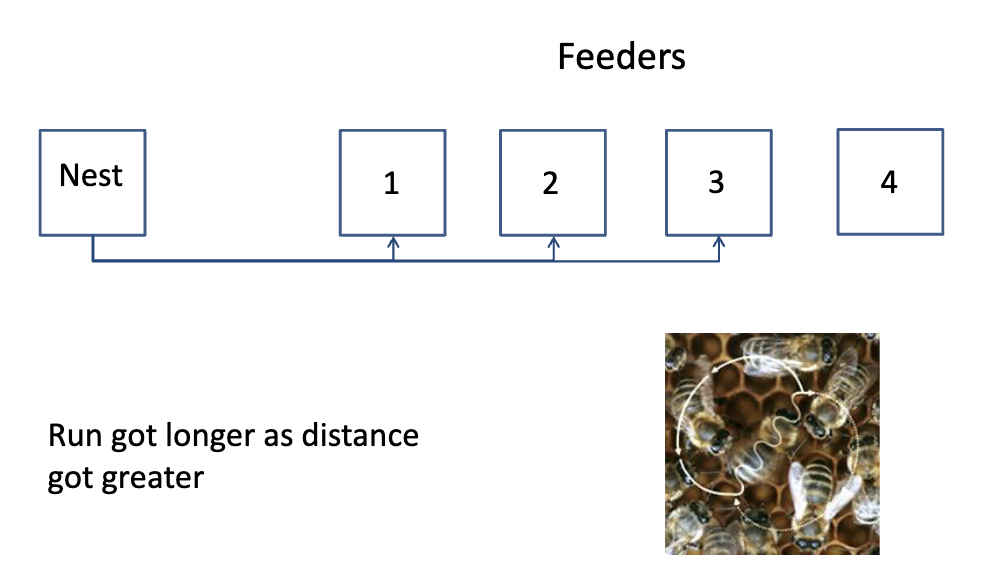
Direction Experimental design (Von Frisch)
Food source was moved the same distance but in different directions. As the angle of the feeder changed, the angle of the dance changed.
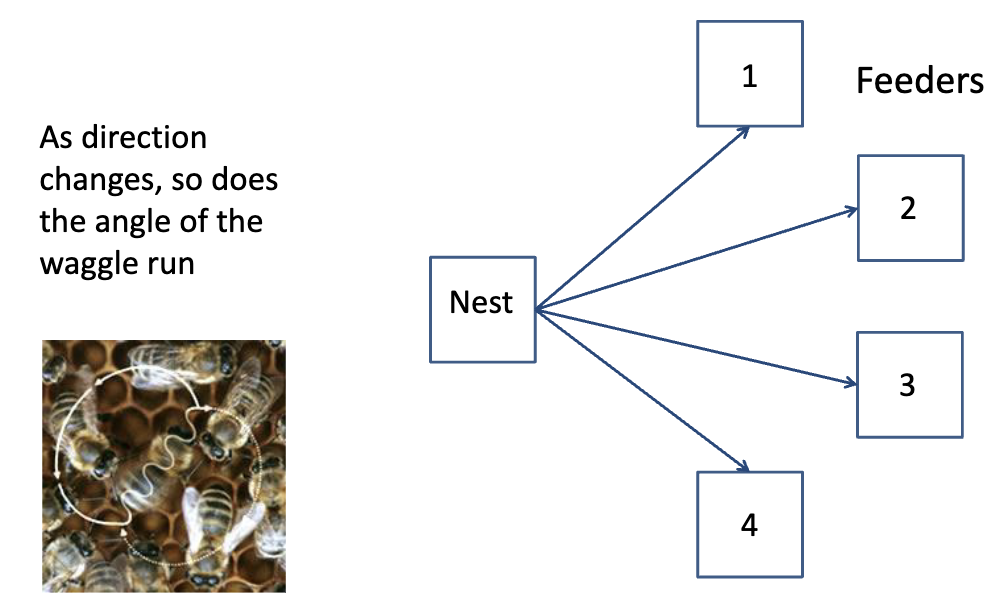
How do bees communicate the quality of a food patch?
The number of waggle dances the bee performs correlates to the quality of the food
How do bees determine site quality?
Bees use energy gain as metric for site quality
a combination of distance from nest and nectar concentration
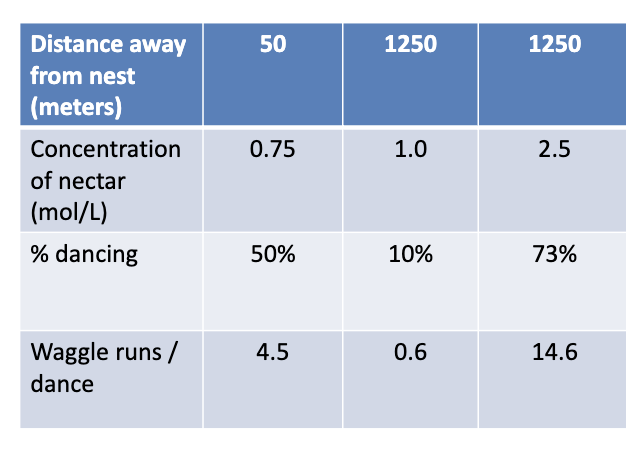
via what sensory modalities is the waggle dance communicated?
releasing pheromones (a blend of hydrocarbons)
send sound, motion, and vibrations
How do bees measure distance?
optic flow: the rate of image flow across the retina
Optic flow experiment
make foragers fly down a narrow tube to a feeder
narrow tube increases optic flow, but not time or energy used
Results: recruits of bees that flew down tunnel flew significantly further, indicating the original bee communicated a farther distance
pheromones
chemicals secreted by an animal that elicit a response from another animal (usually a member of the same species)
often used for sexual, territorial, and social behavior
volatile pheromones
can be smelled from a distance
travels quickly but does not last long
contact pheromones
must be contacted in order to be sensed
short range but lasts a long time
How do pheromones evolve?
They evolve from other chemical compounds produced for other reasons
eg ant trail pheromones come from modified sting gland components
stridulation
type of sound production
Two components:
scraper/plectrum (rigid structure like guitar pick)
file (ridged structure that plecturm scrapes against)
can be many places on the insect depending on need
Cricket stridulatory organ is modified from wings
most grasshoppers have it between their legs and abdomen
Buzzing
type of sound production: modified wing beat frequencies
modified by individual species to contain information
mosquitos use wings in mate attraction
bees use buzzes in dances
Tymbals
type of sound production (functions like drum)
air sac is connected to a flexible cuticle that makes a click, the air sac resonates at the frequency of the clicks and amplifies the sound
found in male cicadas
Pigments
differentially absorb light wavelengths
stable colors
can be extracted and used as dyes
structural colors
more intense, often metallic colors
produced by scattering of light waves
color is only visible from certain angles
How does Lepidoptera mate attraction work?
female releases a volatile mate attraction pheromone
male follows odor plume upwind using zigzag pattern
Artificial pheromone dispensers can cause males to get lost and disrupt mate finding
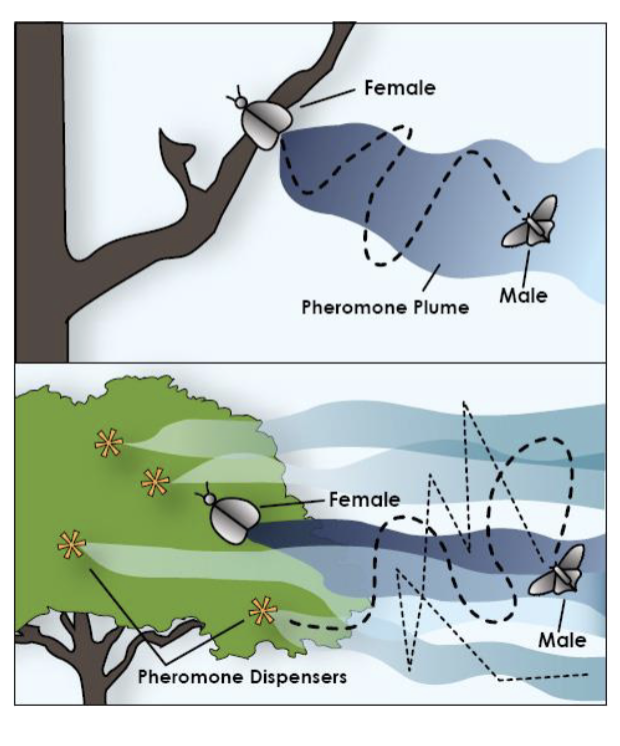
Pheromone mimic example
Bola Spider— mimics moth pheromone to draw in male moths, then catches them using silk lasso
pheromone mimicry is a common strategy used by predators
Ant foraging trails
Ant trails are a blend of contact and volatile pheromones
When the scout find food, she lays a volatile pheromone trail on her way back to the nest, which other ants can then follow to food
The scout also lays a contact pheromone which can be followed again later by the scout to see if old food sources will produce new food. because it is a contact pheromone, the ant must walk slowly with her antennae to the ground
Recruitment mechanisms in ants and bees
Tandem running— one ant guides others to food
Piloting— bees point other bees in the direction of food
How do bark beetles use aggregation pheromones?
bark beetles feed on ponderosa pines, but they cannot overcome the sap defense unless there are many beetles
when a suitable tree is found a beetle releases a pheromone to attract other beetles
The beetles aggregate and overcome the tree defenses, laying eggs inside alongside the help of a symbiotic fungus
When the tree is at capacity the beetles stop releasing the aggregation pheromone and start releasing a “spacing” pheromone to stop other beetles from arriving
Cicada songs
cicadas have long larva stage and short adult stage
adult males have a chorusing song that is very loud to attract females
females approach and give a clicking sound to indicate receptiveness
males then switch to courtship signaling, then mate
process is not well understood
Warning sounds
many insects hiss or make sudden sounds when disturbed, which is meant to startle the predator and allow the insect to escape
bullet ants click while orienting to potential predators
Aposematic coloration
bright coloration to indicate danger/ toxicity
Predator either learns to avoid these colors or instincively avoids them
Mullerian mimicry
All toxic animals in an area are similarly colored
predator can learn from one species and they all benefit
common in butterflies and hymenoptera
Batesian Mimicry
palatable animal mimic toxic animal to avoid predation
mimic is usually rare relative to the animal they mimic (otherwise predator will not get enough negative reinforcement)
Ant mimicry
ants are often feared, so pretending to be an ant is adaptive
ants are often mimicked by spiders
Founders of chemical ecology
Thomas Eisner- animal behaviorist
Jerry Meinwald- chemist
Worked together at cornell
Formed under the basis that chemicals are central to much of animal behavior
Bombadier Beetle study
The bombadier beetle can spray scalding water into the face of a predator when captured
Two components are involved:
Quinone (repellent)
Hot water vapor
Quinone is stored in inactive components, then created and sprayed out when needed
Uthesia sexual selection (mating pheromone study)
Study 1: mating pheromone
male moths separated into two groups; One fed crolataria beans which contain toxins and the other fed pinto beans with no toxin
showed that the brushes males use during mating store a pheromone directly derived from the toxic chemicals they consume as caterpillars
Uthesia sexual selection (Mating gifts)
Study 2: Mating gifts
both males and females contribute defensive chemicals to the eggs
Study designed in which groups were matched with mates that did not have the sequestered toxin, then measured how much each egg received from each parent
found that female gives nearly all of the toxins in her body while males give only 15%
Males with the most defensive compound sequestered are more likely to be chosen
________ is the context in which chemical communication is the most complex.
Social behavior
Nestmate recognition
labels= cues or signals produced by individuals
each individual has a template (set of labels)
labels of other bee are compared to personal template
if template matches, individual is accepted
template made up of different hydrocarbon chains which vary in length and side groups
Footprint pheromone
Bees mark flowers which they have foraged on. The next bee to arrive smells the pheromone and knows it has recently been foraged, so it is most likely empty
Nasonov pheromone
Essentially a homing beacon
used to guide bees to a location
Examples of species manipulating others
Cuckoos
orchids and wasps
slave making ants
Two types of slave making ants
Type 1: larva stealer
slave making ants steal larva from other ant colonies; colony pheromone makes them believe that they belong
some species are totally dependent on slaves as they are only specialized for fighting
Type 2: Social parasite
One ant takes over the queen from another nest by killing host queen and using her pheromone
parasite queen raises parasite eggs alongside her own
Purpose of mosquito hum
specific mate attraction call
allows mosquitos to recognize members of their own species
How was the Johnstons organ verified in mosquito mate recognition
In the 1948 study by Roth, males were “called” with tuning forks and behavior was recorded
When the tuning fork was struck males flew toward the sound and began mating behaviors
Ablation experiments were conducted in which certain structures were removed and response was recorded. Those with removed antenna showed no response
Important to note that this was a lab study, not a field study
How was mate finding in mosquitos investigated?
Mosquito buzzing cannot be heard from very far away, so there must be some way for mosquitos to congregate and find mates
in the 1970 study by Hartberg, mosquitos were caught before and after biting people
they discovered that both males and females are attracted to humans, and mating is occurring near the host
Sexual selection in crickets
The 1994 study by Hedrick looked at female preference for different types of male calls
They found that females prefer males with long trills over males with short trills
Presumably trill length is an indicator of male quality
Sympatric speciation
reproductive isolation without geographic isolation
two species form from one population in one place
Allopatric speciation
Two populations are isolated geographically
Species diverge over time
Pre-reproductive barriers
Factors causing males and females to not mate
can be behavioral or physical
Post-reproductive isolation
animals of two different species can mate but the offspring have reduced fitness
mules are a common example
Rhagoletis fly case study (sympatric speciation)
Rhagoletis larva develop on fruits and nuts, overwintering as pupae and emerging before fruits are ready, then mating occurs on fruits
Rhagoletis pomonella flies historically used hawthorne as a host, but when apples were introduced some switched to apples
100 years later the apple vs hawthorne flies differ in many ways including body size and emergence time
Each fly morph is shown to prefer the fruit in which they hatched
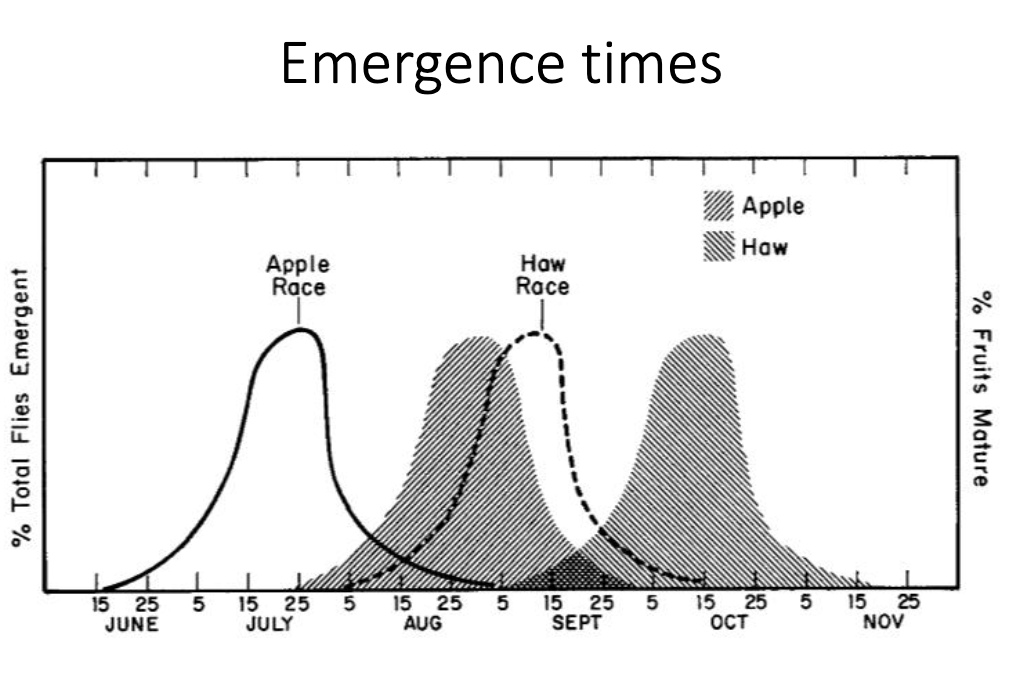
male male competition (sexual selection)
males fight over access to females
often involves evolution of elaborate weapons in males and sexual dimorphism
Female choice (sexual selection)
Females choose the best male based on elaborate mating displays
Best can mean many things:
best provider (good territory, best gifts, etc
most healthy
best genes
Two dung beetle morphs
Alpha male (dominant)
large size, large horns
bonds and mates with female
helps build and guard nest
Sneaker male
much smaller, looks like female
sneaks into nest to mate with female
often have larger and more sperm than alpha male in order to promote his own fitness
Sperm competition
male competition within reproductive tracts
often occurs in multiply mated societies
males compete to make more sperm and larger sperm so that their sperm is more likely to succeed
Often produce substances (eg sperm plug) that interfere with other male sperm
Dung beetle ecological role
Dung beetles break down dung that would otherwise harden and cover the landscape
Unremoved dung can block plant growth and breed flies
Dung beetles in Australia
When large amounts of ungulates were introduced to australia as livestock, dung began to pile up because there were no beetles to break it down
The dung beetles in australia were not specialized for sheep and cow dung and did not clean it up
Dung beetles were brought in from South Africa and France to remove the dung with some success
Leks
Places where males congregate to participate in mating rituals and advertise themselves
usually 99% of matings go to one male
Females perform all parental care after mating
Orchid bees
tropical bees which collect scents from orchid to use in mating
males with the most complex odors are most often chosen by females
odor complexity corresponds with age which indicates greater fitness because they lived a long time